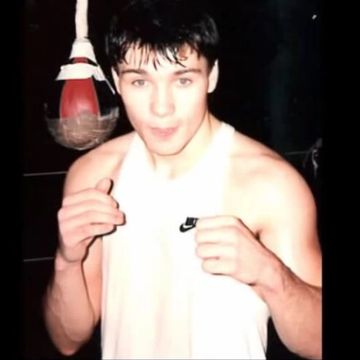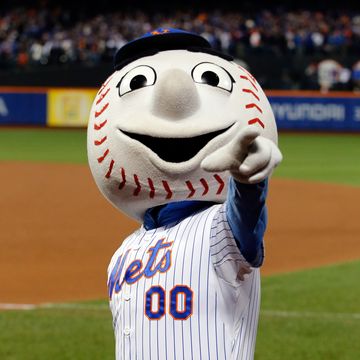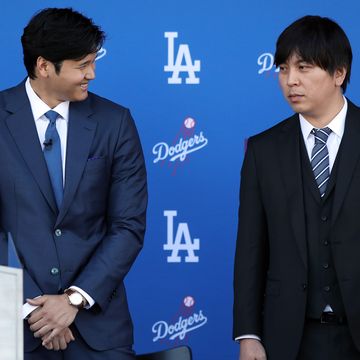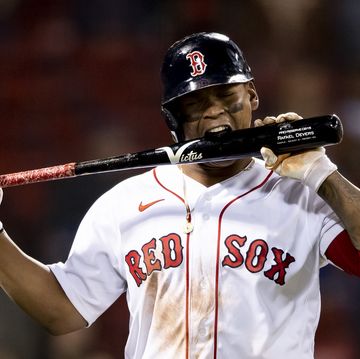Eight or nine years ago—he can't remember exactly—Laird Hamilton started looking at golf courses differently than the rest of us. The surfing legend and his friend Don Wildman, whom we called "The World's Healthiest 75-Year-Old" in 2008, were looking for ways to make golf more appealing to habitually active people like themselves. Naturally, they turned to boards. "We had all these downhill skateboards, electric skateboards, mountain boards, and all these different apparatuses we used in our desire to ride boards of all types," Hamilton says. "We put an electric skateboard on the golf course and immediately realized it was an incredible way to play."
After years of slow but steady research and development, the extreme athletes now have a product they think will revolutionize the way golf is played. It's called the GolfBoard, and with a solid, four-wheeled base and stabilizing handle that extends upward from the nose, golfers adventurous enough to hop on are able to effectively windsurf their way around the course, using their body weight to push or pull the board's trajectory in the direction of their next shot.
"It seems to be answering all the needs of the game itself," Hamilton says of his invention, which wowed skeptical onlookers at the 2014 PGA Merchandise Show. "We have data. We know it makes good players play better. We know it's a way to get new players to play. It speeds up the game immensely. There doesn't seem to be anything left other than trying to break through some of the mentalities that restrain change."
That last thing left, convincing a golf establishment deeply rooted in tradition to embrace "boarding," is no small thing. Hamilton says the GolfBoard's entire marketing strategy was created around the expectation that resistance would be fierce, and admits he's a little surprised at the limited extent to which the GolfBoard has encroached into the golfing world. Though the GolfBoard has seen some success so far, the sport would do well to open its arms even wider to such a radical aesthetic intrusion. The state of professional golf is healthier than it's been in years, but the number of Americans actually taking to the course has been on the decline. Participation among the 18- to 30-year-old demographic has decreased 35 percent over the last decade, and far more courses have closed than open every year over around the same span of time. Golfing isn't close to as accessible to the average American as it was when Nicklaus and Palmer were in their prime. Now more than ever, it's associated with the super-rich, and few have the patience to trudge through a five-hour round, much less shell out a thousand dollars or more for a set of clubs.
Hamilton is convinced the GolfBoard is the answer. Not only is it fun, it speeds the pace of play dramatically and offers a core workout that can't be had by slouching in a cart. "If this thing doesn't explode and isn't at every course in the world, it'll be because we didn't do something right, not because it shouldn't be and not because it isn't a real product."
Earlier this month, a friend and I drove to the eastern end of Long Island, New York, to test the GolfBoard at the Hampton Hills Golf and Country Club. The club is a bastion of a leisurely ideal that could have been plucked straight from golf's heyday. Members are tanned to perfection and at retirement age or close to it. Men smoke cigars on a patio that overlooks the 18th green while women play mahjong and canasta in a well-lit ballroom inside. It's the kind of place that helps give golf its elitist reputation and discourages the average American from picking up a set of clubs and trying it out. If that's a harsh generalization, it's also a common one, especially among younger potential players.
But Hampton Hills general manager Stanley Pine and his partner Barry Beil pride themselves on holding a practical, laissez faire attitude toward their club. Though it is a country club, they don't want it to feel stuffy or exclusionary. When a member told them about the GolfBoard last year, they were wary at first, but quickly changed their tune when they saw one firsthand. In early July, they added four GolfBoards to their fleet of electric carts and couldn't be happier. "The members who have tried the GolfBoard have across the board loved it," Pine says. "I haven't heard anything negative."
"The only negative thing has been that a couple of guys came in and wanted to use them but they were already out on the course," Beil adds.
Before taking to the course, we had to demonstrate that we could maneuver the GolfBoard without incident. Stepping on for the first time, I was surprised at how easy it was to control, though it did take some getting used to. The base of the board is far heavier than you might expect—it needs to be to keep from flipping over as you lean into turns—and working it into and out of tight spaces is difficult. In general, it's easy to use, but probably not as easy as the promotional video filled with smiling middled-aged men, women, and children effortlessly carving across fairways leads you to believe. Most of the curious members asking about it when they saw us zoom by on the course thought it was interesting, but seemed averse to the idea of trying it themselves. I couldn't blame them.
But the experience of actually golfing with the board transcended the basics of holding a thumb to the throttle and shifting your weight left and right. After hitting each shot, we'd hop on and head straight for the middle of the course's lush, atypically hilly fairways, leaning into every undulation and gearing ourselves up to shred our way down the more precipitous declines. Wind ripped over us as we traversed the suddenly playground-like terrain at a whopping 12 miles per hour, the GolfBoard's top speed. We arrived at our balls refreshed and with clear heads, which is the key to what might be the GolfBoard's most pleasant perk.
Golf is a sport that necessitates a kind of Zen-like clearheadedness. The more you think, the worse you play. Between shots, if you're thinking about the wind in your hair and indulging in the contours of the hills before you, then you're not thinking about your golf swing or how you should've gone with a three wood instead of a five wood on that last shot. And most importantly, you're not stressing about the shot you're about to take. All you're doing is having fun until you arrive at your ball, step off the board, assess the shot, and take the shot. The GolfBoard turns the sometimes mentally excruciating time between shots into an involuntary meditation. You're more present in your surroundings, which invariably makes you a better golfer.
Hamilton recognizes this, of course, as surfing requires a similar "letting go," and so do Pine and Beil, only they don't use such existential language to articulate it. "The reason we were so enthusiastic about the GolfBoard is that it doesn't change the way you play golf," Beil says. "The experience, we think, is enhanced, but the game itself isn't screwed around with."
When I asked them what they see for the future of the GolfBoard, Pine responded by saying that he expects it to "grow exponentially."
For now, the GolfBoard advertises that it's available at over 100 courses, which is a small fraction of the near 15,000 facilities nationwide. The vast majority of golfers have never seen or heard about the GolfBoard, and those who have likely saw it in passing and dismissed it as ridiculous. That was my initial reaction, and Pine and Beil's initial reaction, and that's likely to be the initial reaction of anyone who has grown up with the game of golf and its traditions.
But the key to accepting the GolfBoard, for me and Pine and Beil, and for anyone interested in using it, is to actually get on one and play around. For how strange it is, the experience of riding it seems totally normal after only a few minutes on the course. It feels like it truly belongs on the course, just as viable as a cart or pushcart. Some days you might prefer to sit and relax in a cart; other days, if you're in a hurry—we finished our round in just under four hours and took our time—or feel you need a workout, you might prefer the GolfBoard. As Hamilton puts it, it's a "real product," which is saying a lot in a golf equipment landscape that's full of gimmicks.
GolfBoard's potential to catalyze a golf revival probably lies somewhere between Hamilton's lofty expectations and the dismissiveness of stodgy traditionalists. The forces that have pushed an already marginalized sport even further to the margin over the past decade-plus are too great and too complex to be corrected by any single device. But it's certainly a step in the right direction—younger potential golfers need to be enticed somehow—and after playing a round on one, I'm confident in saying the sport would be better off if every course had a stock of GolfBoards, which isn't a position I expected to hold when I first sat at my computer cackling at how absurd the riders looked in the promo video. Some things you really do need to try.













